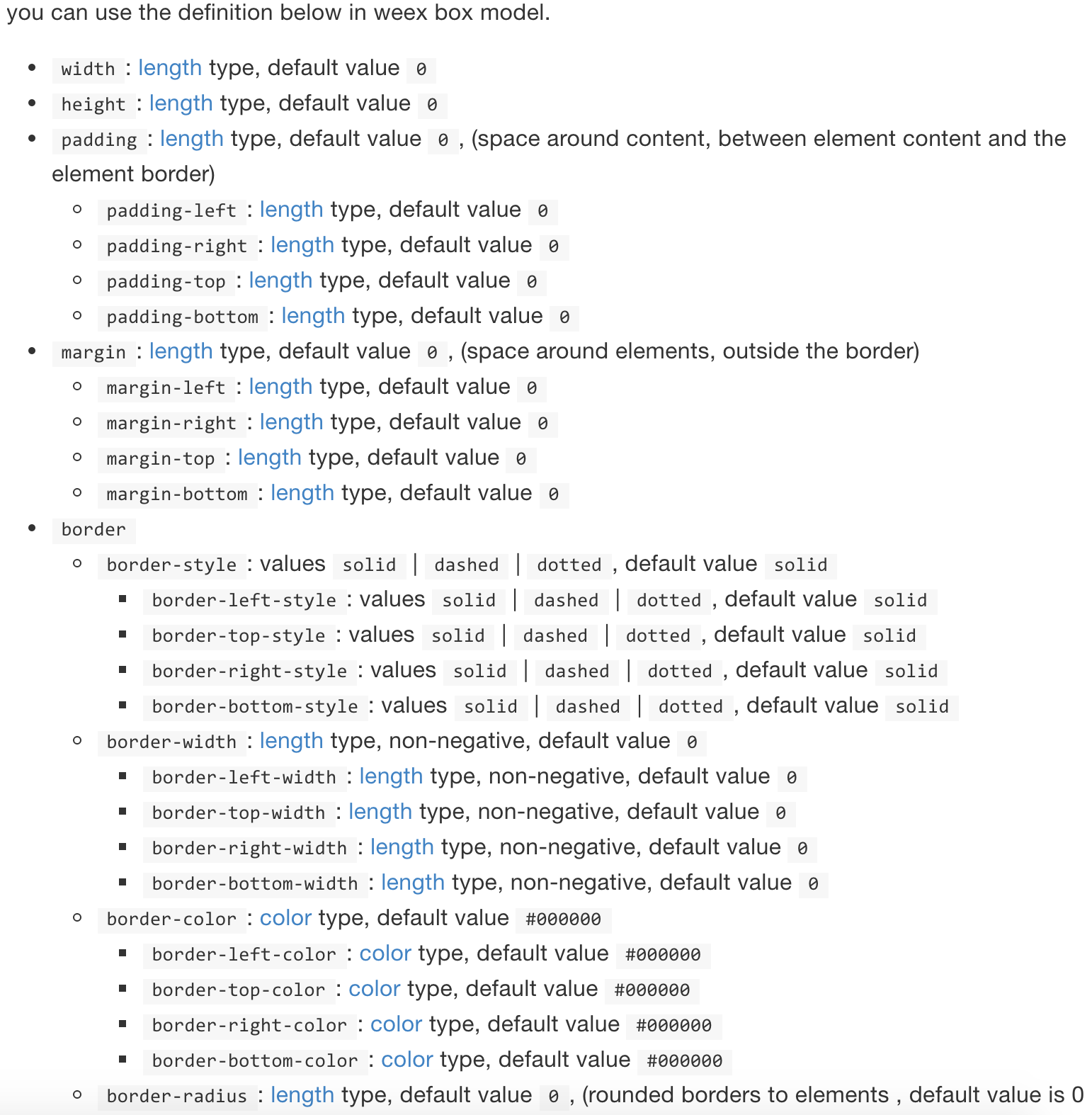第5篇 模版、样式、JavaScript
模版的概念,应该是前端借鉴了后端,不仅可以做到逻辑与视图分离,进行数据绑定,还可以提高开发效率,减少维护成本。Weex的模板语法也是极简的。
一、template
模版概述
在.we文件中,template里面的内容就是视图模版。例如:
<template>
<!-- (required) the structure of page -->
</template>
有几点需要注意的:
1)不建议template的内容层次太深
2)template内必须包含唯一的根节点作为父容器, div就是一个很好的选择
<template>
<div>
<div>子组件</div>
<div>子组件</div>
</div>
</template>
3)template内部组件必须是weex官方提供的组件。例如:div、text、input、web等。这里的组件就不是单纯的html标签了,更加丰富的含义应该是三端一致的基础组件。
模版逻辑
一般情况,我们可以在模版中进行逻辑判断和表达式运算。Weex也做了基础的逻辑运算工作。
<template>
<div>
<div if="{{shown}}">子组件</div>
<div>子组件</div>
</div>
</template>
shown为bool类型的变量。如果为true,则显示该组件,否则移除该组件。
<template>
<container>
<container repeat="{{list}}">
<image src="{{avatar}}"></image>
<text>{{nickname}}</text>
</container>
</container>
</template>
repeat接受循环的数组变量。repeat内部组件引用数组中某一元素的属性,例如list[i].avatar。
<div repeat="{{list}}">
<text>No. {{$index + 1}}</text>
<div>
可以通过$index 拿到数组遍历的索引。
<div repeat="{% raw %}{{v in list}}{% endraw %}">
<text>No. {{$index + 1}}, {{v.nickname}}</text>
</div>
<div repeat="{% raw %}{{(k, v) in list}}{% endraw %}">
<text>No. {{k + 1}}, {{v.nickname}}</text>
</div>
二、样式
Weex的样式基本上是web标准样式的子集。Weex样式分为内联样式和类样式。
<div style="width:100;height:100;margin-left:10;"></div>
<template>
<div class="header_container border"></div>
</template>
<style>
.header_container{
width:100;
height:100;
margin-left:10;
}
.border{
border-width:1;
}
</style>
我们可以看到内联样式基本上和Web标准一样。但是这里不要使用px,因为默认的宽度和高度单位就是px。
类样式,我们写在<style>里面,基本和Web标准一致。但是我们需要注意几个问题:
1. Weex支持哪些样式?
1)样式的形式:内联style属性、style标签内部类样式
2)基础样式:包括盒子模型和Flexbox

Weex支持的公共样式在这里都基本说明了:http://alibaba.github.io/weex/doc/references/common-style.html
3) 文本的样式:因为text组件是一个相对特殊的组件,有着自己的特有属性。例如font-size设置字体的大小。lines设置文本的行数。可以参考:
http://alibaba.github.io/weex/doc/references/text-style.html
http://alibaba.github.io/weex/doc/components/text.html
2. 样式是否支持数据绑定
答案:支持。
<template>
<container>
<text style="font-size: {{fontSize}};">Alibaba</text>
<text class="large {{textClass}}">Weex Team</text>
</container>
</template>
<style>
.large {font-size: 32;}
.highlight {color: #ff0000;}
</style>
<script>
module.exports = {
data: {
fontSize: 32,
textClass: 'highlight'
}
}
</script>
例如fontSize、textClass就是数据绑定。如果不了解数据绑定,可以移步到下一节。
三、JavaScript
首先,这里我们需要明确JavaScript的范围以及JavaScript如何使用。在Weex中,我们使用 mustache的语法形式{{}}来进行数据绑定。我们在script中的data属性上进行的数据绑定,都会自动的映射到视图,从而进行视图的更新。 例如:
<template>
<container>
<text style="font-size: {{size}}">{{title}}</text>
</container>
</template>
<script>
module.exports = {
data: {
size: 48,
title: 'Alibaba Weex Team'
}
}
</script>
这里,我们不仅对样式进行了数据绑定,同样对text组件中的文本进行了数据绑定。
当然,weex也支持,简单的表达式,例如:
<template>
<container style="flex-direction: row;">
<text>{{firstName + ' ' + lastName}}</text>
</container>
</template>
<script>
module.exports = {
data: {
firstName: 'John',
lastName: 'Smith'
}
}
</script>
我们将firstName + ' ' + lastName进行了运算。
那么,如果我们的模板中有大量的逻辑。我们怎么办?
<template>
<container style="flex-direction: row;">
<text>{{fullName}}</text>
<text onclick="changeName" style="margin-left:10px;">CHANGE NAME</text>
</container>
</template>
<script>
module.exports = {
data: {
firstName: 'John',
lastName: 'Smith'
},
computed: {
fullName: {
get: function() {
return this.firstName + ' ' + this.lastName
},
set: function(v) {
var s = v.split(' ')
this.firstName = s[0]
this.lastName = s[1]
}
}
},
methods: {
changeName: function() {
this.fullName = 'Terry King'
}
}
}
</script>
我们可以使用computed对字段进行相关的逻辑运算。
那么,我们又如何给一个元素绑定事件?
直接onclick就好,注意是全部小写。例如:
<template>
<text onclick="toggle">Toggle</text>
</template>
<script>
module.exports = {
methods: {
toggle: function () {
// todo
}
}
}
</script>
每个组件有各自的事件,因此,可以通过 http://alibaba.github.io/weex/doc 多多阅读和了解。
四、组件的范畴和需要关注的点
在HTML中,我们称div这些为标签。但是,这里,我们建议text、div、input、a、web等等这些称之为组件。因为他们是跨三端协作一致的结果。那么作为一个组件,我们需要关注什么呢?
//good case
<list></list>
//bad case
<list/>
组件的内容或者子组件是什么?
例如text组件:This component supports no child components but a text content.
因此,在使用text组件时不要有子组件,但是可以有文本内容。
组件支持的属性有哪些?
比如list组件是否支持纵向/横向滚动,这些都是需要阅读文档时需要注意的。
组件支持什么样的样式
组件支持什么样的事件
比如input组件是不允许子组件的,同时不支持click事件,支持input/change事件。这些是需要我们关注的点。
Weex文档中未出现的组件能否使用?
可以,自己把他扩展成三端一致的组件呗,:)
